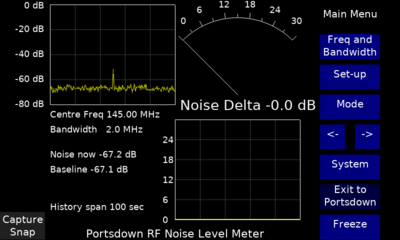Difference between revisions of "Portsdown Noise Meter"
| Line 13: | Line 13: | ||
===Absolute Noise Measurement=== | ===Absolute Noise Measurement=== | ||
| + | On starting the meter, select the frequency and bandwidth required. Connect the receiver or preamp to the input of the LimeSDR and, on the setup menu, adjust the Lime Gain so that the noise level is around -60 dB. Noise background noise levels below this are outside the linear range of measurement. Press the "Establish Baseline" button and the meter should read near zero. Any increases in noise from the baseline level will then register on the meter. | ||
| + | The meter scale can be change through 6 ranges by touching the right and left sides of the meter face. The ranges are | ||
| + | |||
| + | * 0 to 30 dB (default) | ||
| + | * 20 to 30 dB | ||
| + | * 10 to 20 dB | ||
| + | * 0 to 10 dB | ||
| + | * 0 to 5 dB | ||
| + | * -5 to +5 dB | ||
===Differential Noise Measurement=== | ===Differential Noise Measurement=== | ||
Revision as of 18:39, 22 April 2023
The Portsdown Noise Level Meter uses a LimeSDR to measure and indicate noise or carrier power levels. It has 3 modes:
- Absolute Noise Measurement
- Differential Noise Measurement
- Carrier Level Measurement
Absolute noise measurement is used to measure Sun or Moon noise. The system can be "zeroed" against cold sky, and then the meter will indicate the increase in noise averaged over a wide bandwidth. Differential noise measurement can be used to measure the strength of DATV transmissions or possibly to optimise aerial/receiver matching. The noise power in a reference (quiet) frequency range is measured and compared with the noise power in a frequency range that contains a DATV signal. The Carrier Level measurement compares the peak level of a carrier within a defined frequency range with the average noise level in a quiet frequency range.
The Noise Level Meter is selected from Menu 2, Test Equipment.
Absolute Noise Measurement
On starting the meter, select the frequency and bandwidth required. Connect the receiver or preamp to the input of the LimeSDR and, on the setup menu, adjust the Lime Gain so that the noise level is around -60 dB. Noise background noise levels below this are outside the linear range of measurement. Press the "Establish Baseline" button and the meter should read near zero. Any increases in noise from the baseline level will then register on the meter.
The meter scale can be change through 6 ranges by touching the right and left sides of the meter face. The ranges are
- 0 to 30 dB (default)
- 20 to 30 dB
- 10 to 20 dB
- 0 to 10 dB
- 0 to 5 dB
- -5 to +5 dB
